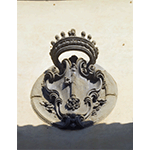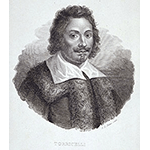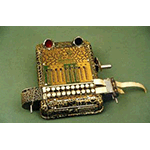Mathematics and physics in Tuscany

The demands of trade favoured the development of mathematical studies already in the mercantile Florence of the age of Dante. Apart from this empirical connotation, with Humanism mathematics was the preferred tool of philosophers to demonstrate the coherence of the universe. Once again, it was thanks to the means offered by studies in geometry and mathematics that the artists of the period arrived at theorising and realising natural perspective. In the centuries that followed, elitist environments of the Tuscan academies and universities made decisive contributions to this century-old process of knowledge, thanks to important personalities like Evangelista Torricelli or, in more recent times, Enrico Betti.

The Arithmetic Schools
Tuscany’s relationship with the mathematical sciences dates to the early 13th century when the most famous arithmetic schools of the time appeared in Florence, such as the Santa Trinita workshop where famed mathematician Paolo dell’Abaco taught practical mathematics to future merchants. In private arithmetic schools, but often financed by the communes, new arithmetic techniques were defined, proportions were studied, practical rules for calculating areas and volumes were invented, and the study of algebra and geometry was cultivated. Numerous arithmetic treatises were written by Tuscan teachers: the oldest, dating to 1290, is Lo livero dell’abbecho secondo la oppinione de maiestro Leonardo della chasa degl’ figliuogle Bonacie da Pisa, today conserved in the Riccardiana Library of Florence. This work represented the foundation of medieval mathematics, and was the first to introduce the use of Arabic numerals and positional notation which made for rapid arithmetic and geometric calculations.
The Platonic Academy
In the Age of Humanism came the recovery and development of the mathematical studies that were to have a decisive role for the birth of modern science. The mathematical works produced in these years in Tuscany were considerably widespread in Italy and the rest of Europe, thanks to the invention of printing and the birth of public libraries. Along with the works published in those years, the library of the convent of San Marco in Florence also collected numerous ancient scientific codices which were later translated and printed. In the ambit of the activity of the Platonic Academy in Florence, important mathematical works of antiquity were recovered, translated and circulated. In 1491, Agnolo Poliziano wrote to Lorenzo the Magnificent that in Venice he had found several books by Archimedes «which we do not have». Along with the rediscovery of the works by the Syracusan, the writings of Euclid, Pythagoras and Ptolemy were also printed and commented. In 1509, Tuscan mathematician Luca Pacioli, author of the famous Summa de arithmetica, geometria, proportioni et proportionalità, one of the first mathematical works to be printed, published a Latin translation with comment of Euclid’s Elements.
The Divine Proportion
Between the late 15th century and the early 16th century, mathematics by now occupied an important place in the culture of the time. Alongside the philosophy of Aristotle and Plato, the geometry of Euclid and Pythagoras was no longer considered only a science of measurement, but also a tool of knowledge. Man, nature, and the entire creation were acknowledged to be subjected to the geometrical rules formulated by Archimedes, Euclid and Pythagoras. By means of the laws of geometry, it was possible to artistically reproduce the reality of a body, of an object, of space. Availing himself of the earlier mathematical studies by Piero della Francesca and Leon Battista Alberti, in 1509 Luca Pacioli published the Divina Proportione in which he laid out the theory of the harmony of geometrical figures, on which were established the proportions of the human figure, of space and of architectural structures.
Mathematics at the University of Florence
In the mid 16th century, during the grand duchy of Cosimo I de’ Medici, the chair of mathematics at the Florentine University was occupied by Egnazio Danti. Author of the Geographical Maps in the Guardaroba of Palazzo Vecchio, and of the astronomical instruments of Santa Maria Novella, in 1573 Danti translated Euclid’s Perspective and Proclus’ Sphere. In 1567, he published the Sette tavole del trattato della sfera and, two years later, a Trattato sull’uso e fabbrica dell’astrolabio. Under the government of Francesco I, Ostilio Ricci, a student of Nicolò Tartaglia, taught mathematics in Florence, and had the merit of teaching geometry to the young Galileo Galilei.
The "Stanzino delle Matematiche": Archimedes and Galileo
Between the late 16th century and the early 17th century, the triumph of Archimedes was painted on the walls and ceiling of the Stanzino delle Matematiche of the Uffizi. Alongside the visual narrative of the undertakings of Archimedes, the frescoes in the Stanzino reproduce the works of Pythagoras, Ptolemy and Euclid, surrounded by the paintings of numerous mathematical instruments then exhibited in the room. In the decorations in the Western Corridor of the Uffizi, Galileo Galilei was celebrated a few years later as the new Archimedes.
Galileo: Mathematics and Physics
In the late 16th century, during the years in which Giulio Parigi painted the frescoes in the Stanzino, Galileo taught geometry to the future grand duke Cosimo II. As his early works show, Galileo experienced the sixteenth-century rebirth of Archimedes. His application of the Syracusan’s rigorous geometrical style to new fields of investigation characterised his studies on gravity, from the treatise on the Bilancetta (Little Balance) to De Motu (On Motion), from the Mechaniche (Mechanics) to work on floating vessels, up to the Discorsi e dimostrazioni matematiche (Discourses and Mathematical Demonstrations). Like Archimedes, Galileo combined mathematical thought and its practical application in the field of physics: he designed and built measuring instruments such as the geometric-military compass and the jovilabe; during his stay in Padua, he patented a device that operated four wells simultaneously.

Studies of Benedetto Castelli and Evangelista Torricelli
The research conducted by Galileo in the field of mechanics and the science of the motion of bodies continued with his students’ studies in physics: Benedetto Castelli, professor of mathematics at the University of Pisa, authored a famous treatise on the speed of waters and several works on the nature of light and colour; Evangelista Torricelli, who succeeded Galileo in the position of Mathematician to the Grand Duke, extended Galileo’s teachings to the motion of fluids, and in the spring of 1644 demonstrated the existence of atmospheric pressure and the possibility of the vacuum.
The Experiments of the Accademia del Cimento
Instituted in Florence in 1657, the Accademia del Cimento was entrusted with the task of relaunching the scientific legacy of Galileo, which had become embarrassing for the Medici after the Pisan scientist’s conviction for Copernicanism by the Church in 1633. The Accademia’s experimental programme was presented as the logical development of Galileo’s lesson, whereby he had reformed vast areas of natural philosophy. In reality, the Galilean legacy was reduced to pure experimentation activity at the Cimento. The experiments, which in any event attained significant results, were mainly concentrated on barometry and thermometry, which were new areas of study stimulated by Torricelli’s experiment. The refined instruments they used - especially the beautiful glassware - were produced by expert glassblowers, heirs of a tradition introduced by the Venetian artificers summoned by Cosimo I in 1569 to set up a factory for a high quality production. The activity of the Accademia ended in 1667 with the publication of the Saggi di naturali esperienze [Essays on Natural Experiments]. An eloquent example of the new scientific prose inaugurated by Galileo, the Saggi proposed a selection of the numerous experiments conducted by the academicians.
The Imperial and Royal Museum of Physics and Natural History of Florence
In the Century of Enlightenment, Tuscan physics turned its attention to studies in electrostatics. For the laboratory of the Museum of Physics and Natural History, Grand Duke Peter Leopold had numerous instruments built and purchased - many of them today conserved at the Institute and Museum of the History of Science - capable of reproducing the most significant and spectacular scientific discoveries: from the large electrostatic machines - such as the one built by Nairne - to apparatuses to demonstrate the properties of lightening rods, from mechanics devices to pneumatic devices.
-
 Museo Galileo - Istituto e Museo di Storia della Scienza [Institute and Museum of the History of Science]
Museo Galileo - Istituto e Museo di Storia della Scienza [Institute and Museum of the History of Science] -
 Museo di Fisica e Storia Naturale
Museo di Fisica e Storia Naturale
-
 Museo Galileo - Section of Room XI. Large machines
Museo Galileo - Section of Room XI. Large machines
-
 Museo Galileo - Section of Rooms XII and XIII. Hydraulics and Pneumatics
Museo Galileo - Section of Rooms XII and XIII. Hydraulics and Pneumatics
-
 Museo Galileo - Section of Rooms XII and XIII. Experimental Apparatus
Museo Galileo - Section of Rooms XII and XIII. Experimental Apparatus
-
 Museo Galileo - Section of Rooms XII and XIII. Simple and Complex Machines
Museo Galileo - Section of Rooms XII and XIII. Simple and Complex Machines
The Physics-Mathematics School in Pisa
In the first half of the 19th century, professor of experimental physics at the University of Pisa Carlo Matteucci inaugurated the Pisan physics-mathematics school in the highest tradition of Galileo, Galvani and Volta. Ottaviano Mossotti, Riccardo Felici, and Enrico Betti were three of the school’s major exponents. Considered the precursor of electrophysiology for his pioneering studies on the electrical phenomenon connected with muscular effort, Matteucci, along with Betti and Felici, founded the journal "Nuovo Cimento", as of 1844 the official organ of the Italian Physics Society. In those same years, the "Annali di matematica pura ed applicata" was founded in Florence, and was the oldest Italian mathematical periodical.

Learning Itineraries for Mathematics and Physics
While the historical itinerary can be easily followed by visiting the collections dedicated to mathematics and physics of the Istituto e Museo di Storia della Scienza (Institute and Museum of the History of Science) and of the Fondazione Scienza e Tecnica di Firenze (Science and Technology Foundation of Florence), a fascinating and educational itinerary can also unfold in several collections of scientific instruments in university departments of mathematics and physics, and in numerous school collections, as well as in other recently created institutions such as the Garden of Archimedes - A Museum for Mathematics in Florence, and the Museum of Calculation Instruments in Pisa.
-
 Fondazione Galileo Galilei - Museo degli Strumenti per il Calcolo [Galileo Galilei Foundation - Museum of Calculation Instruments]
Fondazione Galileo Galilei - Museo degli Strumenti per il Calcolo [Galileo Galilei Foundation - Museum of Calculation Instruments] -
 Fondazione Scienza e Tecnica [Science and Technology Foundation]
Fondazione Scienza e Tecnica [Science and Technology Foundation] -
 Il Giardino di Archimede - Un museo per la matematica [The garden of Archimedes - A Museum for mathematics]
Il Giardino di Archimede - Un museo per la matematica [The garden of Archimedes - A Museum for mathematics]
****************************
Texts by Anna Toscano
English translation by Victor Beard
Last update 09/gen/2008


